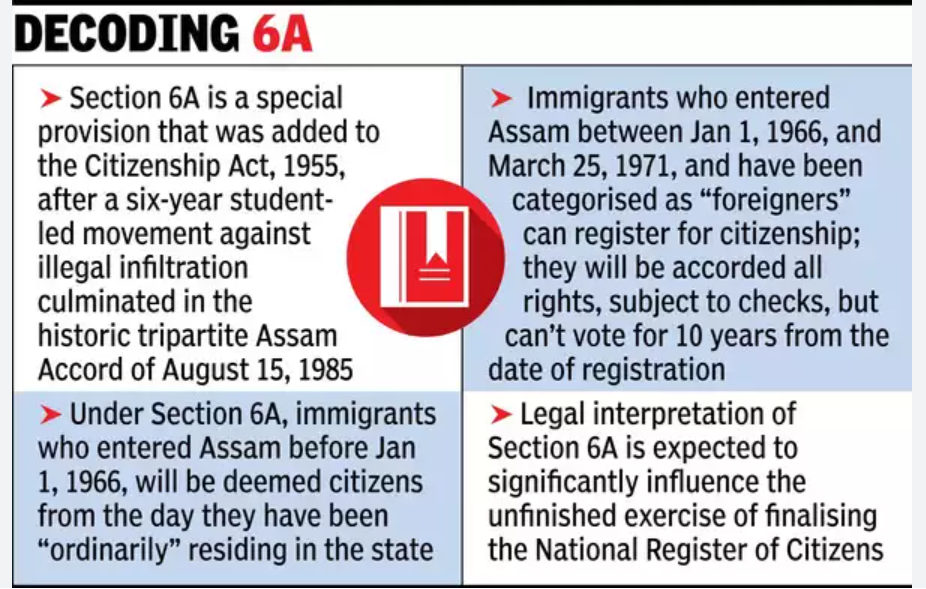Supreme Court Upholds Special Citizenship Provisions for Assam Migrants, Affirms Parliament’s Power Over Citizenship Laws
(Source: Indian Express; Section: Explained; Page: 17)
| Topic: GS2 – Polity |
| Context: |
|
Analysis of News:

Overview of the Verdict
- A five-judge Constitution Bench of the Supreme Court, by a 4-1 majority, upheld Section 6A of the Citizenship Act, 1955. This section provides a unique citizenship process for migrants who entered Assam until March 24, 1971, based on the Assam Accord of 1985.
- The decision is significant for Assam, shaped by migration issues, and for wider questions of citizenship and Parliament’s authority in such matters.
What is Section 6A of the Citizenship Act of 1955?
Background:
-
- Section 6A was enacted as part of the Citizenship (Amendment) Act, 1985, following the Assam Accord of 1985.
-
-
- The Assam Accord was a tripartite agreement between the Central Government, the State Government of Assam, and the leaders of the Assam Movement, which sought to end the influx of illegal migrants from Bangladesh.
-
-
- The Assam Accord, signed in 1985, introduced Section 6A into the Citizenship Act, of 1955, exclusively for Assam.
-
-
- This provision addresses the issue of large-scale migration preceding the 1971 Bangladesh Liberation War. Notably, it mandates the detection and deportation of foreigners who entered Assam after March 25, 1971, marking the creation of Bangladesh.
-
-
-
- The introduction of Section 6A reflects the specific historical and demographic challenges faced by Assam during this critical period.
-
- Provisions and implications:
-
- Section 6A created a special provision for Assam by which persons of Indian origin who came from Bangladesh before 1st January 1966, were deemed to be citizens of India as of that date.
-
- Persons of Indian origin who came to Assam between 1st January 1966, and 25th March 1971, and who were detected to be foreigners, were required to register themselves and were granted citizenship after 10 years of residence, subject to certain conditions.
-
- Persons who entered Assam after 25th March, 1971, were to be detected and deported in accordance with the law.
Parliament’s Power to Regulate Citizenship
- The Court confirmed that Parliament has the power to regulate citizenship under Article 11 and Entry 17 of the Union List.
- It clarified that Articles 6 and 7, which address citizenship post-Partition, apply only to that period.
- Section 6A, introduced much later, is distinct from these provisions and aligns with Parliament’s powers to legislate on citizenship, which may influence future cases, including challenges to the Citizenship (Amendment) Act, 2019.

Right to Equality and Section 6A
- Petitioners argued that Section 6A violated the right to equality as it applied only to Assam and set an arbitrary cut-off date.
- The Court dismissed this, stating that Assam faced a unique situation due to massive influxes of migrants and cultural threats, which justified a special provision for the state.
- The Court emphasized that other border states were not in similar circumstances.
Does Section 6A Allow Illegal Migration and External Aggression?
- The petitioners cited a previous SC ruling (Sarbananda Sonowal vs Union of India) that described illegal immigration as “external aggression.”
- The Court disagreed, asserting that Section 6A regulates migration in a controlled manner and does not promote “unabated” immigration or amount to external aggression.
Cultural Rights of Assamese People
- The petitioners argued that Section 6A violated Article 29(1), which protects cultural rights, by changing Assam’s demography and threatening Assamese culture.
- The majority rejected this, stating that the mere presence of different ethnic groups does not erode the cultural rights of the indigenous population.
- The Court emphasized national fraternity and cohesion, dismissing the argument of cultural threat.
Conclusion
- This judgment reaffirms Parliament’s legislative powers over citizenship, while addressing Assam’s unique situation regarding migration and demographics.
- It also provides important insights into how the Court views the balance between regional cultural concerns and national integration.
| Demographic Impact & Cultural Impact |
|
· Section 6A’s citizenship grant is criticized by some petitioners for allegedly contributing to an influx of illegal migrants from Bangladesh into Assam. · Concerns focus on the unintended consequence of encouraging illegal migration and the resultant impact on the state’s demographic composition. · The petitioners argue that the conferring of citizenship on the migrant population in Assam, as facilitated by Section 6A, amounts to “cementing an illegality.”
|
| PYQ: With reference to India, consider the following statements:
1. There is only one citizenship and one domicile. 2. A citizen by birth only can become the Head of State. 3. A foreigner once granted citizenship cannot be deprived of it under any circumstances. Which of the statements given above is/are correct? (a) 1 only Ans: (a)
|
| Practice Question: Discuss the constitutional validity of Section 6A of the Citizenship Act, 1955 in light of the recent Supreme Court judgment. How does this provision address the unique migration and demographic concerns of Assam, and what are its implications for the broader citizenship laws in India? (250 words/15 m) |
